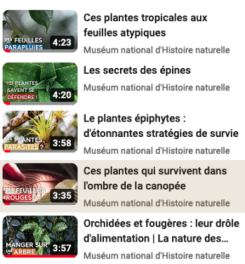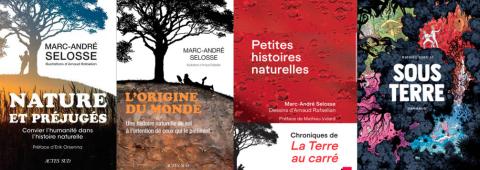
Marc-André SELOSSE



57 rue Cuvier
CP39
75005 Paris
My main research activities focus on soil microbiota and mycorrhizal symbioses, which link most plant roots to soil fungi. I use methods from molecular biology (NGS, transcriptomic) to investigate microbial populations and mycorrhizal communities, which are largely comprised of non-cultivable species. Moreover, isotopic methods (natural abundance of stable isotopes, 13C and 15N) provide efficient tools for investigating plant and fungal exchanges in situ.
I try to keep a strong naturalist eye and expertise in mycology and botany. Using mycorrhizal associations as model systems, my co-workers and I address questions about the ecology and evolution of symbiosis.
I
I am more generally interested in symbiosis and its evolution in general, with a particular penchant for some models, such as the hyper-diverse Sebacinales, the orchid tribe Neottieae and its fascinating albino individuals and truffles (Tuber melanosporum).
This is a team story: as you will see from authors’ names in my publication list, this research would not have been possible without numerous collaborators!
I m an editor of the New Phytologist and an associate editor of Symbiosis, Botany Letters and Ecology Letters as well as Espèces I’m corresponding member of the Académie d’Agriculture de France and of the Institut Universitaire de France.
I am president of Fédération BioGée. I also work in the boards of the French botanical Society, France-Orchidée, the French, Agroforestery Association and Tela botanica.
I teach actively at Muséum and in various universities and ‘grandes écoles’ (AgroParisTech, Ecole Normale supérieure at Paris (rue d’Ulm), Saclay and Lyon, Science-Po Lille, Ecole des Hautes Études en Santé Publique ) and at University of Gdansk (Poland). My topics cover plants, algae and fungi (from biology to ecology), biology of interaction, as well as evolution and general ecology, and I teach as often as possible in the field.
I devote attention to future biology teachers, and invest in outreach by way of talks, field trips, papers, and books: eg. edited by Vuibert on symbiosis (2000), and by Actes Sud on microbiota in plants, animals and civilization (2017, translated into Polish, Dutch, Estonian, and Chinese), on tannins (2019, translated into Italian), on soil (2021) and on various biological topics for a large audience (Petites histoires naturelles, 2021).
Ma recherche est centrée sur la microbiologie du sol et l’interaction mycorhizienne, une symbiose entre les racines de plus de 90% des plantes et des champignons du sol. J’utilise des méthodes issues de la biologie moléculaire (code-barre moléculaire, transcriptomique) pour étudier les populations microbiennes et les communautés mycorhiziennes, qui sont largement dominées par des espèces non cultivables. De plus, les méthodes isotopiques (abondance naturelle des isotopes stables 13C et 15N) fournissent de précieux marqueurs pour étudier la nutrition des organismes, et plus particulièrement les échanges entre les plantes et les champignons in situ
Mes travaux comprennent une activité et une expertise naturaliste (botanique, mycologie). En étudiant l’interaction mycorhizienne, mes collaborateurs et moi-même traitons des questions générales sur l’écologie et l’évolution des symbioses, en particulier celles qui créent des réseaux entre individus et espèces différentes.
Je suis plus globalement intéressé par les symbioses et leur évolution en général, avec un penchant pour certains modèles, comme l’hyper-diversité des Sébacinales, les Neottieae, une tribu d’orchidées aux individus albinos fascinants, et la Truffe noire, Tuber melanosporum.
Mais l’aventure est collective – vous verrez dans les auteurs de mes articles les nombreux collaborateurs sans qui je ne pourrais travailler !
Je suis éditeur du New Phytologist et éditeur associé de Symbiosis et Botany Letters et Ecology Letters mais aussi à la revue Espèces. Je suis membre correspondant de l’ Académie d’Agriculture de France
et de l’Institut Universitaire de France.
Je suis président de la Fédération Biogée. Je participe aux bureaux de Société botanique de France, de France-Orchidée , de l’Association Française d’Agroforesterie et de Tela Botanica.
Je participe aux comités scientifiques de la Société Française d’Orchidophilie et de Tela Botanica.
J’enseigne activement au Muséum et dans diverses universités et grandes écoles dont AgroParisTech, Ecoles Normales supérieures de la rue d’Ulm (Paris), Saclay et de Lyon, Science-Po Lille, l’Ecole des Hautes Études en Santé Publique et à l’Université de Gdansk (Pologne). Mes cours portent sur les plantes, les algues et les champignons (de la biologie à l’écologie), la biologie des interactions et sur l’évolution et l’écologie en général – sur le terrain aussi souvent que possible. J’enseigne en particulier aux futurs enseignants en biologie-géologie notamment à la préparation à l’Agrégation SV-STU ENS/ParisXI/MNHN. Enfin, je m’investis beaucoup en vulgarisation, par des conférences, des excursions de terrain, des articles (voir infra), et des livres (ci-dessous).
–-


